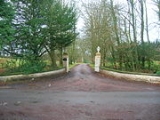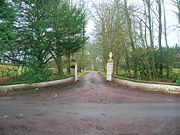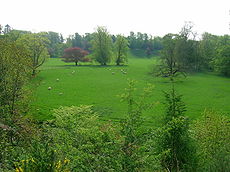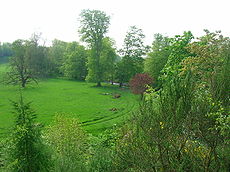
Annick Lodge and Greenville
Encyclopedia
Annick Lodge is an estate between Perceton
and Cunninghamhead
in North Ayrshire
, Scotland
.
. The lodge stands on the site of the old mansion described by Pont as "a proper building, veill planted, the inheritance of Blaire, Laird of Adamtoune." The 11th Earl had died without male issue so the Earldom had passed to Hugh, son of Alexander Montgomerie of Coilsfield (Robertson 1908). The Right Hon. David Boyle of Kelburn
married Elizabeth, eldest daughter of Alexander at Annick Lodge in 1804. Elizabeth, wife of Alexander Montgomerie Esq., died the 13th of February 1839; her beloved daughter Frances died 25th Sept 1858 and both were buried at Dreghorn Parish cemetery.
The second laird of Annick Lodge, who succeeded in 1802, was Lieutenant-Colonel of the Ayrshire Yeomanry Cavalry, a magistrate and deputy-lieutenant of Ayrshire. One of the sons of the family wrote a vocabulary of the American Indians of the Columbia River and Puget's Sound! (Robertson 1908). Major and Mrs Montgomerie attended the famous 1839 Eglinton Tournament in what is now Eglinton Country Park
and were alloted a seat in the Grand Stand. Susan Fraser, wife of William Eglington Montgomerie of Annick Lodge, died the 13th of October 1884 age 84 yrs and is buried in Dreghorn parish cemetery.
 In 1800 Annick Lodge was visited by John Stoddart on his return from his tour of Scotland. Stoddart calls the new house "a complete specimen of the English ferme ornee". Hussey states that this term describes a country estate laid out partly according to aesthetic principles and partly for farming. Ferme ornee were an expression in landscape gardening of the Romantic Movement of 18th. century Europe, i.e. a working farm, domestic animals, natural landscape joined with follies and grottoes, statuary and classical texts combined with avenued walks, flowing water, lakes, areas of light and shade, special plantings and inspirational views.
In 1800 Annick Lodge was visited by John Stoddart on his return from his tour of Scotland. Stoddart calls the new house "a complete specimen of the English ferme ornee". Hussey states that this term describes a country estate laid out partly according to aesthetic principles and partly for farming. Ferme ornee were an expression in landscape gardening of the Romantic Movement of 18th. century Europe, i.e. a working farm, domestic animals, natural landscape joined with follies and grottoes, statuary and classical texts combined with avenued walks, flowing water, lakes, areas of light and shade, special plantings and inspirational views.
The house itself is decorated with a porch supported upon Corinthian pillars, and surmounted by a facade bearing sculptured urns at its three angles. The tympanum
is filled in with a heraldic shield and scroll-work in high relief (Millar 1885). Annick Lodge estate is partly on the site of a previous small estate, called Greenvale, Greenville or Greenval. Aiton records that Annack-lodge had gardens with hot-houses, greenhouse, etc. as early as 1811. The estate had a common boundary march with the Cunninghamhead estate.
The river bed here at Annick Bridge contains animal fossils and some fine specimens were removed by members of the Kilmarnock Glenfield Ramblers. It is now very rural (2006) despite the previous mining and quarrying activity and the presence of the old railway and abandoned estate coal siding nearby. A fine three arched sandstone railway viaduct on the old Glasgow and South Western Railway, later the London, Midland and Scottish, is located just upstream from the Annick Bridge. It was restored to good order in 2005 / 2006, despite being redundant.
The area beside the northern bank of the Annick Water is known as Friersmill Holm. The 'Reid Friers' were the Red Friars, better known as the Knights Templar
and the mill in this vicinity would have been one of many belonging to the order in Scotland, however no indication of its exact site is found on the OS or any other old maps of the district. Strawhorn relates that the 'Friersmiln' belonged to the Carmelite friars at Irvine and held the multures, a fixed proportion of the tenant's grain, paid to the miller by the suckener to grind the corn, of Armsheugh, Roddinghill and Holehouse.
The Annick Lodge policies contain a number of fine specimen trees, especially some very large common oaks.

 The name of a property called Greenville is found on the 1775 Armstrong map and Aiton refers to this country seat as Greenvale in 1811. It is Greenval on Ainslie's 1821 map and Dobie (1876) states that the name was Greenvale. The estate was made up of all the mains lands of Over-Pearston, sometimes called Pearston-Blair, acquired by Alexander Montgomerie, second son of Alexander Montgomerie of Skelmorlie and Coilsfield, in 1790. His mother was Lillias Montgomerie, heiress of Skelmorlie and he was born in 1744. He also purchased the old estate of Braehead and the lands of Roddinghill (previously Redenhill in 1775 and Ruddinghill in 1832), giving the name Annick Lodge to the collective whole. Part of the old 'proper building' of Pont's day (17th. C.) was exposed during repair work on Annick Lodge in the 1870s.
The name of a property called Greenville is found on the 1775 Armstrong map and Aiton refers to this country seat as Greenvale in 1811. It is Greenval on Ainslie's 1821 map and Dobie (1876) states that the name was Greenvale. The estate was made up of all the mains lands of Over-Pearston, sometimes called Pearston-Blair, acquired by Alexander Montgomerie, second son of Alexander Montgomerie of Skelmorlie and Coilsfield, in 1790. His mother was Lillias Montgomerie, heiress of Skelmorlie and he was born in 1744. He also purchased the old estate of Braehead and the lands of Roddinghill (previously Redenhill in 1775 and Ruddinghill in 1832), giving the name Annick Lodge to the collective whole. Part of the old 'proper building' of Pont's day (17th. C.) was exposed during repair work on Annick Lodge in the 1870s.
lodge had gardens with hot-houses, greenhouse, etc. as early as 1811. The estate had a common boundary march with the Cunninghamhead estate.
Perceton
Perceton is a medieval settlement and estate in North Ayrshire, Scotland, near the town of Irvine. The old church in Perceton is one of the oldest buildings in the Irvine district...
and Cunninghamhead
Cunninghamhead
Cunninghamhead is a hamlet in North Ayrshire, Scotland. It was the centre of the lands of Cunninghamhead, Perceton and Annick Lodge in Cunninghame...
in North Ayrshire
North Ayrshire
North Ayrshire is one of 32 council areas in Scotland with a population of roughly 136,000 people. It is located in the south-west region of Scotland, and borders the areas of Inverclyde to the north, Renfrewshire to the north-east and East Ayrshire and South Ayrshire to the East and South...
, Scotland
Scotland
Scotland is a country that is part of the United Kingdom. Occupying the northern third of the island of Great Britain, it shares a border with England to the south and is bounded by the North Sea to the east, the Atlantic Ocean to the north and west, and the North Channel and Irish Sea to the...
.
History
Annick Lodge (previously Annack, Annoch or Annock) and estate was built by Captain Alexander Montgomery, the brother German of Hugh, Earl of EglintonEarl of Eglinton
Earl of Eglinton is a title in the Peerage of Scotland.Some authorities spell the title: Earl of Eglintoun In 1859 the thirteenth Earl of Eglinton, Archibald Montgomerie, was also created Earl of Winton in the Peerage of the United Kingdom, which gave him an automatic seat in the House of Lords,...
. The lodge stands on the site of the old mansion described by Pont as "a proper building, veill planted, the inheritance of Blaire, Laird of Adamtoune." The 11th Earl had died without male issue so the Earldom had passed to Hugh, son of Alexander Montgomerie of Coilsfield (Robertson 1908). The Right Hon. David Boyle of Kelburn
Kelburn Castle
Kelburn Castle is a large house near Fairlie, North Ayrshire, Scotland. It is the seat of the Earl of Glasgow. Originally built in the thirteenth century it was remodelled in the sixteenth century. In 1700 the first Earl made further extensions to the house in a manner not unlike a French château...
married Elizabeth, eldest daughter of Alexander at Annick Lodge in 1804. Elizabeth, wife of Alexander Montgomerie Esq., died the 13th of February 1839; her beloved daughter Frances died 25th Sept 1858 and both were buried at Dreghorn Parish cemetery.
The second laird of Annick Lodge, who succeeded in 1802, was Lieutenant-Colonel of the Ayrshire Yeomanry Cavalry, a magistrate and deputy-lieutenant of Ayrshire. One of the sons of the family wrote a vocabulary of the American Indians of the Columbia River and Puget's Sound! (Robertson 1908). Major and Mrs Montgomerie attended the famous 1839 Eglinton Tournament in what is now Eglinton Country Park
Eglinton Country Park
Eglinton Country Park is located in the grounds of the old Eglinton Castle estate, Kilwinning, North Ayrshire, Scotland . Eglinton Park is situated in the parish of Kilwinning, part of the former district of Cunninghame, and covers an area of 400 hectares...
and were alloted a seat in the Grand Stand. Susan Fraser, wife of William Eglington Montgomerie of Annick Lodge, died the 13th of October 1884 age 84 yrs and is buried in Dreghorn parish cemetery.

The house itself is decorated with a porch supported upon Corinthian pillars, and surmounted by a facade bearing sculptured urns at its three angles. The tympanum
Tympanum (architecture)
In architecture, a tympanum is the semi-circular or triangular decorative wall surface over an entrance, bounded by a lintel and arch. It often contains sculpture or other imagery or ornaments. Most architectural styles include this element....
is filled in with a heraldic shield and scroll-work in high relief (Millar 1885). Annick Lodge estate is partly on the site of a previous small estate, called Greenvale, Greenville or Greenval. Aiton records that Annack-lodge had gardens with hot-houses, greenhouse, etc. as early as 1811. The estate had a common boundary march with the Cunninghamhead estate.
The river bed here at Annick Bridge contains animal fossils and some fine specimens were removed by members of the Kilmarnock Glenfield Ramblers. It is now very rural (2006) despite the previous mining and quarrying activity and the presence of the old railway and abandoned estate coal siding nearby. A fine three arched sandstone railway viaduct on the old Glasgow and South Western Railway, later the London, Midland and Scottish, is located just upstream from the Annick Bridge. It was restored to good order in 2005 / 2006, despite being redundant.
The area beside the northern bank of the Annick Water is known as Friersmill Holm. The 'Reid Friers' were the Red Friars, better known as the Knights Templar
Knights Templar
The Poor Fellow-Soldiers of Christ and of the Temple of Solomon , commonly known as the Knights Templar, the Order of the Temple or simply as Templars, were among the most famous of the Western Christian military orders...
and the mill in this vicinity would have been one of many belonging to the order in Scotland, however no indication of its exact site is found on the OS or any other old maps of the district. Strawhorn relates that the 'Friersmiln' belonged to the Carmelite friars at Irvine and held the multures, a fixed proportion of the tenant's grain, paid to the miller by the suckener to grind the corn, of Armsheugh, Roddinghill and Holehouse.
The Annick Lodge policies contain a number of fine specimen trees, especially some very large common oaks.
Greenville


lodge had gardens with hot-houses, greenhouse, etc. as early as 1811. The estate had a common boundary march with the Cunninghamhead estate.
Annick Lodge's landscape components
The Components of the designed landscape are from the 18th and 19th centuries, superseding earlier landscape phases of which little is known. As regarding listed buildings, Annick Lodge is Category A; the Gateway (See photograph) is Category B and the Bridge near Annick Lodge (footbridge to the northwest of the Lodge) is Category C.Architectural features
Around 100 yards east of the footbridge, between the house and the riverbank, there is a gravestone of red sandstone inscribed: "Philip of SP-Annie 1939-1947".See also
- CunninghamheadCunninghamheadCunninghamhead is a hamlet in North Ayrshire, Scotland. It was the centre of the lands of Cunninghamhead, Perceton and Annick Lodge in Cunninghame...
- Cunninghamhead, Perceton and Annick Lodge
- Cunninghamhead EstateCunninghamhead EstateThe Cunninghamhead Estate is in the 21st century mainly a residential caravan park with two private residences near Irvine, Scotland. It was once a private estate, owned by a sequence of recorded families since around 1418. The Mansion House, one of Britain's lost houses, was built in 1747; it was...
- PercetonPercetonPerceton is a medieval settlement and estate in North Ayrshire, Scotland, near the town of Irvine. The old church in Perceton is one of the oldest buildings in the Irvine district...
- Clan MontgomeryClan Montgomery-Origins of the Clan:Clan Montgomery originated in Wales, and emigrated to Scotland in the 12th century as vassals of the FitzAlans. The family derives its surname from lands in Wales, likely from the Honour of Montgomery which was located near the Shropshire lands of the FitzAlans...
- A Researcher's Guide to Local History terminology

